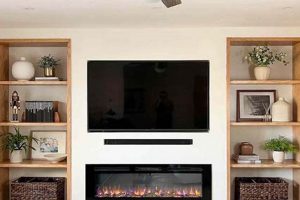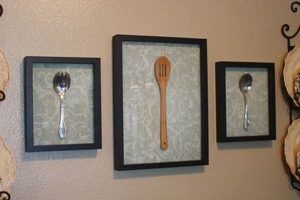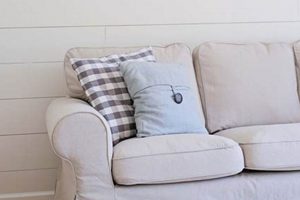A decorative interior design element, constructed from wood, that homeowners assemble and install themselves to create a visually distinctive wall. This feature serves to highlight or emphasize a particular area within a room. For instance, a reclaimed lumber panel applied to a bedroom wall behind the headboard acts as a focal point, drawing attention and adding texture.
The appeal of this design choice lies in its accessibility and cost-effectiveness. It empowers individuals to personalize their living spaces without the expense of professional installation. Historically, similar wall treatments were prevalent in upscale residences, signifying wealth and craftsmanship. Modern iterations democratize this aesthetic, enabling widespread adoption and customized expression.
The subsequent sections will delve into material selection, preparation techniques, installation methodologies, and finishing options relevant to achieving a successful outcome in creating this impactful design element. Detailed guidance will be provided to navigate each stage of the process, ensuring a visually appealing and structurally sound result.
Essential Considerations for Wood Wall Creation
The successful construction and installation of a decorative wood wall require careful planning and execution. The following guidance provides crucial considerations for achieving a professional and enduring result.
Tip 1: Material Selection: The choice of wood significantly impacts the aesthetic and structural integrity. Consider reclaimed wood for a rustic appearance or select hardwoods for a more refined finish. Ensure the wood is properly acclimated to the room’s environment to minimize warping or cracking post-installation.
Tip 2: Surface Preparation: Thoroughly clean and prepare the existing wall surface. Remove any loose paint or debris and ensure the wall is level. Addressing imperfections at this stage prevents issues with the finished project.
Tip 3: Precise Measurements: Accurate measurements are essential for a seamless fit. Measure the wall multiple times and account for any irregularities or obstacles, such as outlets or windows. Precise measurements minimize material waste and installation complications.
Tip 4: Secure Attachment: Employ appropriate adhesives and fasteners to securely attach the wood to the wall. The method chosen should be suitable for the wall material and the weight of the wood. Insufficient attachment can lead to detachment and potential hazards.
Tip 5: Consistent Spacing: Maintain consistent spacing between individual wood pieces to achieve a uniform appearance. Utilize spacers or shims to ensure even gaps. Irregular spacing detracts from the overall visual appeal.
Tip 6: Proper Sealing: Apply a sealant or finish to protect the wood from moisture and damage. The selection of sealant should complement the wood type and intended aesthetic. Unprotected wood is susceptible to warping, staining, and deterioration.
Tip 7: Careful Cutting: When cutting wood pieces to size, use appropriate tools and techniques. Precise, clean cuts are essential for a professional-looking finish. Avoid splintering and uneven edges by using sharp blades and appropriate cutting speeds.
Adherence to these considerations will enhance the visual impact and longevity of the wood wall, providing a durable and aesthetically pleasing interior design element.
The subsequent section will discuss advanced techniques and design considerations for those seeking to further refine their decorative wood wall projects.
1. Material Selection
Material selection directly dictates the aesthetic, durability, and installation process of the decorative wood wall. The type of wood chosen influences the overall appearance, ranging from rustic to contemporary, and its inherent properties affect resistance to moisture, warping, and wear. For example, reclaimed wood introduces a weathered character, while cedar offers natural resistance to insects and decay. The selected material also impacts the ease of cutting, fastening, and finishing, thereby influencing the overall project complexity and timeline.
Consider a homeowner opting for lightweight pine for a bedroom wall. Its affordability and ease of cutting simplify the project. Conversely, selecting a denser hardwood like oak presents a more robust and elegant finish, but necessitates specialized tools and expertise for accurate cuts and secure installation. Incorrect material selection can result in structural instability, compromised aesthetics, and premature deterioration. For instance, using untreated softwood in a high-humidity environment can lead to mold growth and structural damage.
The appropriate choice hinges on budget, design preferences, and environmental factors. Understanding the properties of different wood types, coupled with a realistic assessment of skill level and available resources, forms the bedrock of a successful project. The material selection becomes not merely a stylistic decision, but a fundamental determinant of the wall’s long-term performance and visual impact. A strategic approach mitigates potential problems and maximizes the return on investment.
2. Wall Preparation
Wall preparation is a foundational element impacting the success of a decorative wood wall project. Improper preparation creates a cascade of potential issues, affecting the structural integrity and visual appeal of the final product. A dirty or uneven wall surface impedes adhesive bonding, leading to potential detachment of the wood panels. For example, a wall previously covered in wallpaper must be thoroughly stripped and cleaned to remove any residual adhesive, which would otherwise compromise the bond between the wood and the wall. Similarly, cracks or holes must be filled and leveled to provide a consistent plane for installation. This foundational step is not merely cosmetic; it directly affects the longevity and stability of the installed wooden feature.
Consider a scenario where a homeowner installs wood planks directly onto a textured wall without first leveling the surface. This results in uneven planks, visible gaps, and a generally unprofessional appearance. Furthermore, moisture trapped between the wood and the unprepared wall can promote mold growth and wood rot, leading to costly repairs. Proper preparation involves cleaning, sanding, patching imperfections, and potentially applying a primer to enhance adhesion. The specific steps will vary based on the wall’s existing condition, but the underlying principle remains consistent: a well-prepared surface is essential for a durable and aesthetically pleasing outcome. A primed and smooth wall also allows for more precise alignment and consistent spacing between wood elements.
In conclusion, meticulous wall preparation represents a critical investment of time and effort. It mitigates potential structural problems, enhances aesthetic quality, and contributes to the longevity of the decorative wood wall. While the specific techniques may vary depending on the existing wall surface, the fundamental principle of ensuring a clean, level, and structurally sound foundation remains constant. This upfront investment ultimately translates into a more durable and visually satisfying final product.
3. Design Layout
Effective design layout is fundamental to the successful creation of a visually compelling decorative wood wall. The arrangement of individual wood elements determines the overall aesthetic impact and contributes significantly to the perceived quality and harmony of the finished design. Thoughtful planning, accounting for room dimensions, wood grain direction, and spacing, ensures a cohesive and intentional outcome.
- Pattern Selection
The selection of a specific pattern, such as herringbone, geometric, or random, dictates the visual texture and style of the feature. A herringbone pattern, for example, introduces a classic and sophisticated aesthetic, while a random pattern creates a more organic and rustic feel. The chosen pattern must complement the existing interior design and reflect the desired ambiance. Inconsistent or poorly executed pattern application detracts from the design.
- Wood Orientation
The orientation of the wood elements, whether horizontal, vertical, or diagonal, influences the perceived dimensions of the space. Horizontal orientation tends to visually widen a room, while vertical orientation can create a sense of height. Careful consideration of wood grain direction further enhances the visual effect. Inconsistent grain patterns can appear disjointed, highlighting the importance of thoughtful arrangement. The orientation dictates flow, adding to the desired aesthetic of a room.
- Spacing and Gaps
The spacing between individual wood pieces impacts the overall texture and visual rhythm of the surface. Consistent spacing provides a uniform and polished look, while varying the spacing introduces a more textured and dynamic effect. The size and style of the gap also contributes the aesthetic. Excessive or uneven gaps detract from the design, emphasizing the necessity of precise measurements and consistent execution. The desired aesthetic can be tailored for individual needs.
- Color and Texture Variation
Incorporating variations in wood color and texture adds depth and visual interest to the wood wall. Strategically placing darker and lighter pieces, or mixing different wood species, creates a more dynamic and engaging aesthetic. However, uncontrolled variation can result in a chaotic and visually jarring effect. Balancing consistency with intentional variation is crucial for achieving a refined and sophisticated design.
These facets of design layout, when carefully considered and executed, contribute significantly to the overall success of a decorative wood wall. A well-planned layout enhances the visual appeal, complements the existing interior design, and creates a cohesive and harmonious space. Conversely, a poorly conceived or executed layout diminishes the aesthetic impact and can detract from the overall quality of the room. Therefore, dedicating time and effort to meticulous design layout is essential for realizing the full potential of a diy wood wall project.
4. Adhesive Application
The selection and application of adhesive represents a critical component in the creation of a decorative wood wall, directly influencing its long-term stability and aesthetic integrity. The adhesive serves as the primary bonding agent between the wood elements and the underlying wall surface, ensuring a secure and lasting connection. Improper adhesive selection or application techniques can compromise the entire structure, leading to detachment, warping, and premature failure.
- Adhesive Type Selection
The choice of adhesive depends on several factors, including the type of wood, the wall surface material, and environmental conditions. Construction adhesives, specifically designed for bonding wood to various surfaces, are generally recommended for their strength and versatility. For porous surfaces like drywall, a high-quality construction adhesive offers superior adhesion compared to general-purpose adhesives. In high-moisture environments, moisture-resistant adhesives are essential to prevent bond degradation and mold growth. Selecting the wrong adhesive compromises the long-term stability of the wooden wall feature.
- Surface Preparation for Adhesion
Effective adhesive bonding requires proper surface preparation. The wall surface must be clean, dry, and free of loose paint, dust, or other contaminants. Textured walls should be leveled to provide a uniform bonding surface. Priming the wall can enhance adhesion, particularly on porous surfaces. Neglecting surface preparation reduces the adhesive’s ability to form a strong bond, increasing the risk of detachment. For instance, failing to remove wallpaper residue prevents the adhesive from properly bonding with the drywall.
- Application Technique and Coverage
Proper adhesive application involves applying a consistent and adequate amount to both the wood and the wall surface. A zigzag pattern or perimeter bead ensures uniform coverage and maximizes bonding strength. Insufficient adhesive application results in weak spots and potential detachment. Excessive adhesive application can lead to squeeze-out, requiring cleanup and potentially affecting the finished appearance. Following the manufacturer’s instructions regarding application technique and coverage is essential for achieving optimal results. The technique defines the overall integrity of wood wall.
- Curing Time and Environmental Conditions
Adhesive curing time is influenced by temperature, humidity, and ventilation. Sufficient curing time allows the adhesive to fully bond with the wood and wall surfaces, maximizing its strength. Prematurely stressing the bond before the adhesive has fully cured can compromise its integrity. Maintaining appropriate environmental conditions during curing promotes optimal bonding. High humidity or extreme temperatures can impede the curing process and weaken the bond. Patient is the key for this step.
These facets of adhesive application are intricately linked to the success of any diy accent wood wall. Meticulous attention to adhesive selection, surface preparation, application technique, and curing conditions is essential for achieving a durable, visually appealing, and long-lasting installation. Compromising on any of these aspects significantly increases the risk of structural failure and diminishes the overall aesthetic impact. Therefore, adherence to best practices in adhesive application is a crucial investment in the quality and longevity of the wooden feature.
5. Cutting Precision
Cutting precision is an indispensable element in achieving a professional finish when undertaking a wooden wall project. The accuracy of cuts directly affects the alignment and uniformity of the individual wood pieces, influencing the overall aesthetic appeal of the final installation. Deviations from precise measurements can result in visible gaps, misaligned patterns, and an unprofessional appearance. For instance, in a herringbone pattern, even slight inaccuracies in the angle and length of each piece will compound, leading to a noticeably flawed and visually unappealing design. Consequently, the investment in appropriate cutting tools and techniques is paramount to ensure a high-quality outcome and a successful realization of the intended design.
The selection of tools significantly influences cutting precision. A miter saw, for example, allows for accurate angle cuts, essential for intricate patterns and tight-fitting joints. Circular saws, when used with a guide, enable straight and consistent cuts for planks or panels. Conversely, relying on hand saws without proper guidance often results in uneven cuts and imprecise angles. Furthermore, blade sharpness directly impacts the quality of the cut. A dull blade can cause splintering and tear-out, requiring additional sanding and potentially compromising the integrity of the wood. Thus, maintaining sharp blades and using the appropriate tools for the task are critical to achieving clean, precise cuts.
In summary, cutting precision is not merely a technical detail but a fundamental aspect of a successful wooden wall project. Accurate cuts ensure proper alignment, uniform spacing, and an aesthetically pleasing design. The selection of appropriate tools, maintenance of sharp blades, and adherence to precise measurement techniques are all essential components of achieving cutting precision. While meticulous attention to detail is required, the resulting improvement in the final product justifies the investment of time and effort, transforming a potentially amateur endeavor into a professional-quality design feature.
6. Finishing Techniques
The application of appropriate finishing techniques is critical to enhance the aesthetic appeal and protect the structural integrity of a decorative wood wall. These techniques extend beyond mere surface coatings, encompassing a range of processes that refine the wood’s appearance, enhance its durability, and mitigate potential damage from environmental factors.
- Sealing and Protection
Sealing involves applying a protective layer to the wood surface to prevent moisture absorption, staining, and damage from ultraviolet radiation. Polyurethane, varnish, and lacquer are commonly used sealants, each offering varying degrees of protection and sheen. For instance, applying a marine-grade varnish to a wood wall in a bathroom protects it from humidity and water damage. Proper sealing significantly extends the lifespan of the wood and preserves its aesthetic appeal. Failure to seal properly invites accelerated decay.
- Staining and Coloration
Staining allows for altering the color of the wood to match existing interior design elements or to achieve a specific aesthetic. Stains penetrate the wood fibers, imparting a desired hue while allowing the natural grain to remain visible. Applying a dark walnut stain to a pine wood wall transforms its appearance to resemble a more expensive hardwood. Incorrect stain application leads to uneven coloration, highlighting the need for proper technique and preparation. Without color, a space becomes stale.
- Texturing and Distressing
Texturing and distressing techniques add character and visual interest to the wall. These methods can include wire brushing, sanding, or physically distressing the wood to create a weathered or aged appearance. A reclaimed wood wall, for example, often benefits from wire brushing to enhance the texture of the grain and highlight imperfections. Over-distressing, however, can detract from the overall design and compromise the structural integrity of the wood. Balance is always ideal in these situations.
- Application Methods
The method of application significantly impacts the final finish quality. Brushing, spraying, and wiping are common techniques, each offering varying degrees of control and uniformity. Spraying lacquer, for example, allows for a smooth, even finish with minimal brushstrokes. However, spraying requires proper ventilation and safety precautions. Uneven application or improper technique results in streaks, drips, and an unprofessional appearance. Proper care must be taken.
In summation, the selection and execution of appropriate finishing techniques are indispensable for achieving a durable and visually appealing decorative wood wall. These techniques not only enhance the aesthetic qualities of the wood but also provide critical protection against environmental factors, extending the lifespan and preserving the beauty of the design. Consistent high standards and proper application should be followed during these processes.
7. Secure Installation
Secure installation constitutes a fundamental requirement for any decorative wood wall. Its importance stems from the necessity of ensuring both the longevity and safety of the structure. A compromised installation can lead to detachment of wooden elements, posing a potential hazard to occupants and resulting in costly repairs. The connection between the wooden design feature and its supporting wall relies on a robust and well-executed installation process. For instance, insufficient anchoring of heavy wooden panels can result in their gradual displacement and eventual collapse, particularly in environments subject to vibrations or temperature fluctuations. The integrity of the overall design is therefore inextricably linked to the security of its installation.
Practical application involves selecting appropriate fastening methods based on the wall material and the weight of the wood. Drywall, for example, requires the use of anchors to distribute the load and prevent the fasteners from pulling through. Concrete walls necessitate specialized drilling and anchoring techniques. Adhesives, while useful for initial bonding, should not be relied upon as the sole means of securing heavier wood elements. A combination of adhesives and mechanical fasteners, such as screws or nails, provides a more reliable and durable solution. Careful attention to spacing and alignment during installation ensures a uniform distribution of weight and minimizes stress on individual fasteners. Real-world examples reveal that neglecting these considerations often leads to premature failure of the installation, requiring extensive remediation and potentially causing structural damage to the underlying wall.
In summary, secure installation is not a mere afterthought but an integral component of a decorative wood wall project. Challenges often arise from improper material selection, inadequate surface preparation, or reliance on inappropriate fastening methods. By understanding the principles of secure installation and implementing best practices, homeowners can ensure the longevity, safety, and aesthetic integrity of this design element. The broader implications extend beyond mere visual appeal, encompassing structural stability and the prevention of potential hazards within the living space.
Frequently Asked Questions
This section addresses common inquiries and misconceptions regarding the creation and installation of decorative wood walls, providing clear and concise information to assist in project planning and execution.
Question 1: Is specialized expertise required for construction?
While prior woodworking experience is beneficial, it is not strictly necessary. Careful planning, adherence to instructions, and the use of appropriate tools enable successful completion even by those with limited experience. Projects involving intricate patterns or complex designs may warrant seeking professional assistance.
Question 2: What is the typical cost associated with materials?
Material costs vary considerably depending on the type of wood selected and the project’s scope. Reclaimed wood often presents a more economical option than premium hardwoods. Accurate measurement and efficient material usage minimize waste and control overall expenses.
Question 3: How does one ensure the structural integrity of the installation?
Structural integrity hinges on proper wall preparation, appropriate adhesive selection, and the use of mechanical fasteners. Heavier wood elements necessitate secure anchoring to the wall studs. Consult building codes for specific requirements related to wall construction.
Question 4: What are the key considerations regarding moisture resistance?
In environments prone to moisture, such as bathrooms, selecting moisture-resistant wood species and applying a sealant are crucial. Adequate ventilation also mitigates moisture buildup and prevents wood rot.
Question 5: How does one address uneven wall surfaces prior to installation?
Uneven wall surfaces require leveling prior to installation. This involves patching imperfections with wood filler, sanding to achieve a smooth surface, and potentially applying shims to ensure a consistent plane for the wood elements.
Question 6: What safety precautions should be observed during the construction process?
Safety precautions include wearing appropriate personal protective equipment, such as safety glasses and gloves, when cutting and handling wood. Ensure adequate ventilation when applying adhesives or sealants. Exercise caution when using power tools.
In summary, a successful project demands thorough planning, adherence to safety guidelines, and the application of appropriate techniques. While certain aspects of construction may present challenges, careful attention to detail and a commitment to quality craftsmanship yields a visually stunning and enduring result.
The following sections will explore advanced design considerations and innovative approaches to enhancing the aesthetic impact of decorative wood walls.
Conclusion
The preceding exploration has elucidated the critical factors governing the creation of a “diy accent wood wall”, from material selection and wall preparation to cutting precision, secure installation, and appropriate finishing techniques. A comprehensive understanding of these elements is paramount for achieving a durable, aesthetically pleasing, and structurally sound design feature. Addressing each stage with meticulous attention to detail enhances the likelihood of a successful outcome.
The integration of a decorative wood wall represents a significant opportunity to elevate interior design. Prospective installers should carefully consider the information presented herein to inform their approach and mitigate potential challenges. The pursuit of craftsmanship and adherence to established best practices ensures the realization of a visually compelling and enduring design element.







